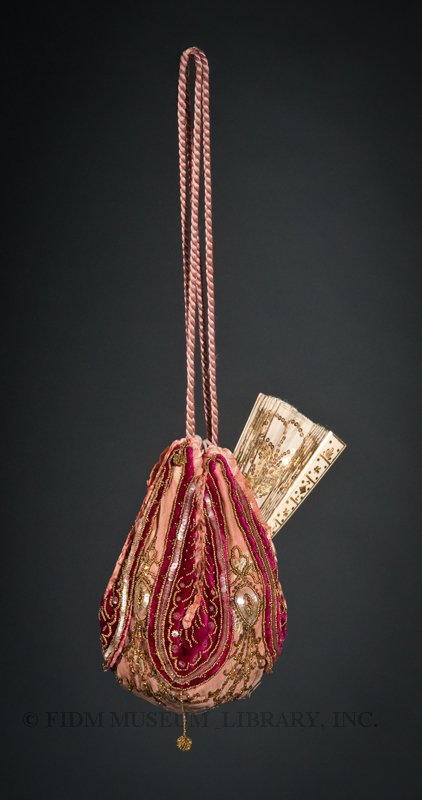The FIDM Museum blog will be on hiatus through early January 2015. In the meantime, enjoy weekly posts from the archives. To keep up with our current projects, find us on Facebook and Twitter, which will be updated regularly during the blog hiatus. This post on a velvet, brocade, and taffeta Duvelleroy fan bag was first published in December 2013.

Fan-bag
1890s
Georges Duvelleroy
Museum Purchase
2008.5.28
Luxury fan maker Jean-Pierre Duvelleroy (1802-1889) founded his namesake company in 1827. By the late nineteenth-century, Duvelleroy was the most prestigious éventailliste (fan maker) in Paris. Fan making was a highly competitive endeavor uniting the best artisans of the day: carvers, jewelers, painters, and lace makers. Seasonal trends meant tremendous sales or else failure for these specialty shops. Therefore, Georges Duvelleroy (1856-1930) diversified the items sold in his father's Rue de la Paix establishment, including offering luxurious bags. This example was probably custom made to complement an ensemble; the same silk brocade and velvet, iridescent taffeta, and mother-of-pearl embroidery could be seen on elaborate opera toilettes of the time. This model has an unusual tulip shape with four long vertical openings that allowed a lady to easily tuck in or pull out a closed fan without opening the drawstrings or removing the bag from her wrist.
As with other fashion accessories, fans offered women an opportunity to display discerning taste, personal style, and financial status. Folding fans were available at all price points, from delicate one-of-a-kind masterpieces to inexpensive paper fans imported from Japan. The most desirable fans were produced in France, with Duvelleroy as the leading maison. In December 1895, Vogue noted that diamond-covered fans cost up to $400, while "charming and graceful" painted Spanish fans could be had for as little as $5.1 As a hobby, some women painted their own fan designs; blank paper fans were sold specifically for this purpose.
Fans also had unique communicative properties. Held in the hand, a fan intensified every gesture. In an era when women were bound by strict ideas regarding personal decorum, fans could help entice or discourage potential suitors. At public gatherings, fans could be used to shield oneself from a "too persistent gaze…or to shelter the whisper of a bending escort."2 The London branch of Duvelleroy reinforced the notion of fan communication by including printed instructions in "The Language of the Fan" with each fan sold.3 Duvelleroy wasn't alone in promoting this language; numerous versions of "The Language of the Fan" were in circulation during the nineteenth-century. Though the exact meaning of these gestures may have escaped the recipient, their codification reinforces the notion that fans were used to facilitate romantic communication. A contemporary version of Duvelleroy's fan language can be found here.
1 "Seen in the Shops: Evening Toilette Accessories." Vogue (Dec. 5, 1895) 394.
2 "Her Point of View." New York Times (Dec. 7, 1890) 12.
3 Beaujot, Ariel. Victorian Fashion Accessories. (London: Berg, 2012) 77.

